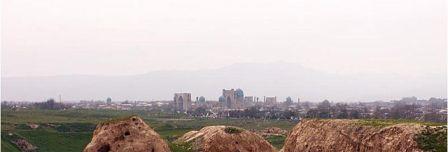|
Category
|
Excavations of the ancient city Afrasiab
During the reign of the Achaemenid Persian Empire (VI cent. BC) the city was surrounded by a high wall with massive internal corridors and towers. Persian Empire in the IV century BC surrendered to the army of Alexander the Great. In 329 BC Greek phalanx entered to Marakanda. Macedonian hike to the East for several years was arrested Sogdians revolt under the leadership of Spitamen, the suppression of which, Alexander destroyed Marakanda. The revival of Sogdiana was at Seleucids.
Archaeological investigations at the Afrasiab were carried out from the end of the XIX century. Archaeological studies have confirmed that several centuries before the BC Samarkand was one of the largest shopping and cultural centers of Central Asia. On the mound of clay samples were found ornamented ware, terracotta statuettes, fragments of ossuaries, glassware, a variety of tools, jewelry, coins. It was found that the city of cobbled streets intersecting lines and divided into quarters - Huzar, was surrounded by thick defensive walls, inside of which was the citadel - Shakhristan, temples, houses and workshops.
On the walls of the palace of the ruler of the city was found a large composition, depicting the procession, headed by a figure on a white elephant, which apparently represented a princess or queen. Apparently, the wedding procession is depicted as an elephant to his bride to the palace of the princess sent, accompanied by friends and important dignitaries. Also on Afrasiab was found a large hall, decorated with wooden sculptures, charred by fire, killed the town thirteen centuries ago. When excavations were also found bas landscape character.
In the XI-XIII centuries, Samarkand became the capital of Karakhanids and was surrounded by new defensive walls. In the citadel was built the palace of Karakhanids. At the beginning of the XIII century Horezmshah Mohammed conquered Samarkand and built a new palace on the site of the palace of Karakhanids. In the XIII century the Khorezm state was conquered by Genghis Khan, Samarkand was captured by the Mongols. During the civil wars of the second half of the XIII century Samarkand suffered greatly, and this led to the complete desolation of the settlement at Afrasiab. In the future, Samarkand has developed on the site of the former "rabad" - the city suburbs. In the Museum of City History, located on the site of Afrasiab collected artifacts of different periods of ancient history of Samarkand - ossuaries, the remnants of ancient swords, knives, arrows, coins, pottery and unique frescoes discovered during excavations at the ancient settlement. After visiting the museum, you can also wander around the Afrasiab, from the height of the hills to admire the panorama of the old city, its blue domes and minarets. Here, the sounds of wind and the rustle of grass your thoughts will seamlessly transfer into the past ...
|
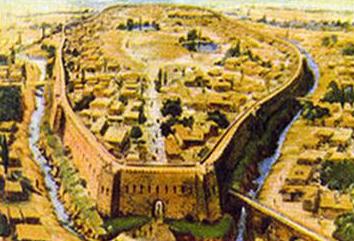 Scientists refer to the beginning of Samarkand VIII - VII centuries BC. It was at this time on the northern edge of modern Samarkand there is an ancient settlement Afrosiab. The area of settlement is more than 200 hectares. From the north and east it was protected by the cliffs of river channels, to the south and west by deep ravines. It is believed that Afrasiab was the ancient capital of the Sogdiana - famous Marakanda. The ancient city got its name - in honor of the legendary king of Turan - Afrasiab and one of the heroes of the poem of the great Persian poet Ferdowsi "Shahnameh".
Scientists refer to the beginning of Samarkand VIII - VII centuries BC. It was at this time on the northern edge of modern Samarkand there is an ancient settlement Afrosiab. The area of settlement is more than 200 hectares. From the north and east it was protected by the cliffs of river channels, to the south and west by deep ravines. It is believed that Afrasiab was the ancient capital of the Sogdiana - famous Marakanda. The ancient city got its name - in honor of the legendary king of Turan - Afrasiab and one of the heroes of the poem of the great Persian poet Ferdowsi "Shahnameh".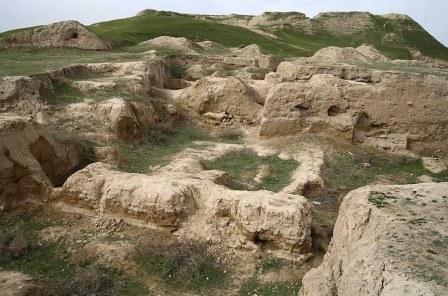 Now Afrasiab - a huge cluster of barren hills. But in the past is full of life, noisy markets, working artisans. This explains the keen interest of scientists to Afrasiab.
Now Afrasiab - a huge cluster of barren hills. But in the past is full of life, noisy markets, working artisans. This explains the keen interest of scientists to Afrasiab.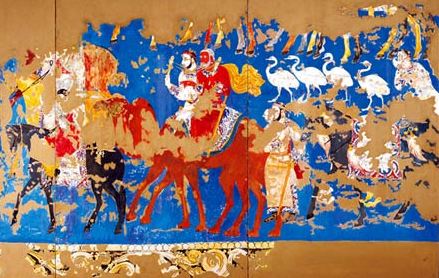 For example, in the exposed buildings, dating from VI-VII centuries, the walls were decorated with highly artistic paintings, made with bright colors of clay adhesive plaster. In one room were found a kind of genre paintings, which are located on the walls in three tiers. They were shown a procession of men and women in festive fancy costumes, accompanied by real and imaginary animals, bearing rich gifts.
For example, in the exposed buildings, dating from VI-VII centuries, the walls were decorated with highly artistic paintings, made with bright colors of clay adhesive plaster. In one room were found a kind of genre paintings, which are located on the walls in three tiers. They were shown a procession of men and women in festive fancy costumes, accompanied by real and imaginary animals, bearing rich gifts.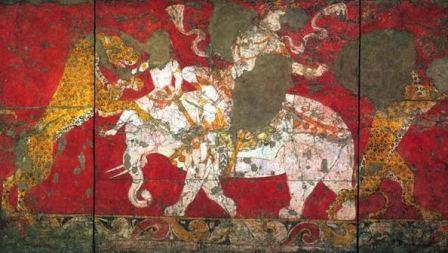 In IX-X centuries, when Samarkand was one of the cultural centers of the Islamic East and the first capital of the Samanid dynasty, in the western part of Afrasiab was built the magnificent royal palace. By the X century the area of the inner part of the city reached 220 hectares. To the south of him was placed in a suburb of bazaars, mosques, baths and caravanserais. The city was built by water from lead pipes "Arzis" and had launched production of paper.
In IX-X centuries, when Samarkand was one of the cultural centers of the Islamic East and the first capital of the Samanid dynasty, in the western part of Afrasiab was built the magnificent royal palace. By the X century the area of the inner part of the city reached 220 hectares. To the south of him was placed in a suburb of bazaars, mosques, baths and caravanserais. The city was built by water from lead pipes "Arzis" and had launched production of paper.